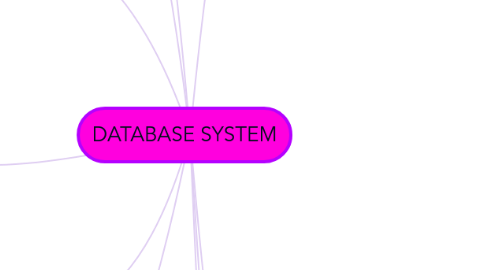
1. DEFINITION OF DATABASE
1.1. Shared collection of logically related data and, designed to meet the information needs of an organization.
2. RDBMS
2.1. Database base on the relational model developed by Dr. E.F. Codd of IBM Research in 1970. A DBMS that manages the relational database
3. COMPONENTS & CHARACTERISTICS OF RDBMS
3.1. RELATION -table with column and rows A relation(table) consists of unique attributes (column) and tuples (rows)
3.2. ATTRIBUTE (FIELD) -An attribute is named column of relation -Used to hold information about the objects to be represented in database
3.3. RECORD (TUPLE) A record is a row of a relation
3.4. DOMAIN A domain is the set of allowable values for one or more attributes
3.5. DEGREE -The degree of relation is the number of attributes it contains -Relationship degree: The number of entities associated with the relationship
4. COMPONENTS & CHARACTERISTICS OF RDBMS
4.1. Download our native mobile apps for iOS and Android to mind map on the go!
5. RELATION INSTANCE
5.1. EXAMPLE Student(sid: char(10), name: char(20), age: integer, gpa: real, login: char(20)).
5.1.1. SCHEMA : specifies name of relation, plus name
5.2. . INSTANCE : a table of values in rows and columns Relation instance is a set of rows (tuples, records) As a set, it is not supposed to have duplicates!
6. RELATIONAL MODEL RELATIONSHIPS
6.1. Express the specific number of entity occurrences associated with occurrences of the related entity
6.2. There are 3 types of relationships; -One to One (1:1) -One to Many (1:M) -Many to One (M:1) -Many to Many (M:N)
6.2.1. ONE TO ONE(1:1)
6.2.1.1. One occurrence of an entity relates to only one occurrence in another entity
6.2.2. One to Many (1:M)
6.2.2.1. One occurrence in an entity relates to many occurrences in another entity
6.2.3. Many to One (M:1)
6.2.3.1. many occurrences in an entity relate to one occurrences in another entity
6.2.4. Many to Many (M:N)
6.2.4.1. many occurrences in an entity relate to many occurrences in another entity
7. RELATIONAL DATA MODEL
7.1. Relational model
7.1.1. Enables programmer to view data logically rather than physically
7.2. What is Database?
7.2.1. database is a collection of information that is organized so that it can easily be accessed, managed, and updated.
7.2.2. databases can be classified according to types of content: bibliographic, full-text, numeric, and images
7.3. Components of Database Table
7.3.1. two-dimensional structure composed of rows and columns
7.3.2. Record (tuple) - is a sequence of attributes -Attribute (field) - named column in the relation table. -Domain - The domain of an attribute defines the set of values which can apply to that attribute. -Degree - The degree of a relation refers to the number of attributes in each tuple. -Cardinality - This refers to the number of tuples in the relation
7.4. Characteristic of Relation Scheme
7.4.1. -Relation name -Attribute name -Domains
7.5. Keys
7.5.1. Consists of one or more attributes that determine
7.5.1.1. Primary Key - Primary key (PK) is an attribute (or a combination of attributes)
7.5.1.2. Superkey - Any key that uniquely identifies each row
7.5.1.3. Composite key - Composed of more than one attribute
7.5.1.4. Candidate key - A superkey without redundancies
7.5.1.5. Foreign key – a field in a relational table that matches the primary key column of another table.
7.6. Integrity Rules
7.6.1. Entity Integrity
7.6.1.1. Requirement
7.6.1.1.1. All primary key entries are unique
7.6.1.2. Purpose
7.6.1.2.1. Each row will have a unique identity
7.6.1.3. Example
7.6.1.3.1. No invoice can have a duplicate number
7.6.2. Referential Integrity
7.6.2.1. Requirement
7.6.2.1.1. A foreign key may have either a null entry
7.6.2.2. Purpose
7.6.2.2.1. It is possible for an attribute NOT to have a corresponding value
7.6.2.3. Example
7.6.2.3.1. A customer might not yet have an assigned sales
7.7. One to Many Relationship
7.7.1. Each entity in the relationship will have exactly one related entity
7.8. Many to Many Relationship
7.8.1. Entities on both sides of the relationship can have many related entities on the other side
7.9. Self Referencing Relationship
7.9.1. Self-referencing relationships are a special case of a normal table relationship
7.9.2. The only difference is that in this case, there is only one table involved and it is on both sides of the relationship.
7.10. Relational Database Operators
7.10.1. Relational algebra
7.10.1.1. Defines theoretical way of manipulating table contents using relational operators
7.10.1.1.1. Restrict (select)
7.10.1.1.2. Project
7.10.1.1.3. Cross Product
7.10.1.1.4. Join (outer, inner)
8. RELATION KEYS
8.1. -Primary Key -Candidates Key -Foreign Key
8.1.1. Primary Key
8.1.1.1. is a column (or columns) in a table that uniquely identifies the rows in that table.
8.1.2. Candidates Key
8.1.2.1. is a column that meets all of the requirements of a primary key. In other words, it has the potential to be a primary key.
8.1.3. Foreign Key
8.1.3.1. are columns that point to primary key columns.
9. Integrity Rules
9.1. Rules of constraints or restrictions that apply to all instances of the database.
9.2. prevents users or applications from entering inconsistent data.
9.3. -Entity Integrity -Referential Integrity
9.3.1. No attribute of a primary key can be null.
9.3.1.1. attributes are needed to distinguish between tuples.
9.3.1.1.1. Null mean that no value
9.3.2. rule applies to a foreign keys.
9.3.2.1. foreign key exist in a relation
9.3.2.1.1. referring to its own candidate key is known as self-referencing table
10. DATABASE DESIGN TECHNIQUE
10.1. Represent conceptual level
10.2. Describe things and their relationships
10.3. - Entity - Attribute - Relationship
10.4. Entity
10.4.1. defining the required entities
10.4.2. can store data about people,place,things,events
10.4.3. Represented by a rectangular box
10.5. Attribute
10.5.1. hold values that describe the properties of entities
10.5.2. Represented by a ellipse
10.6. Relationship
10.6.1. specify the relations among entities from two or more entity sets
10.6.2. Represented by a diamond

